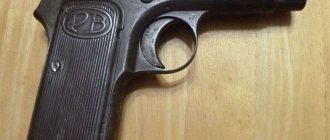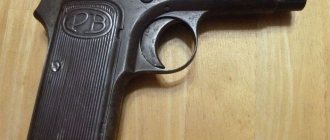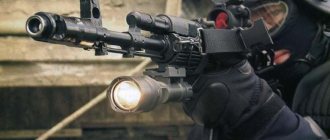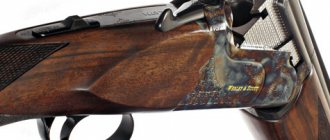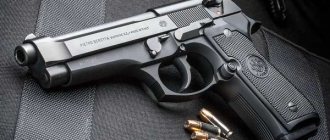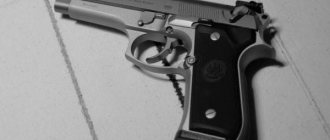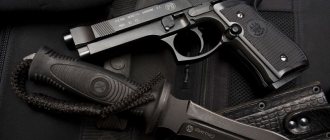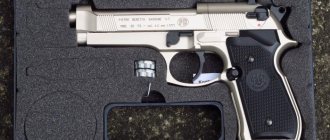In May 1915, Italy enters the First World War. In the first months, there is a need for reliable close combat weapons - pistols. The Glisenti M 1910 pistol, similar to the German parabellum, did not satisfy this need. Then Pietro Beretta comes onto the scene with its own take on the design of a pistol.
This is the look of the 9 mm M1915 model, which quickly replaced all analogues and won a place in the holster of the Italian army. The accuracy and reliability of the new weapon, which made history at the right moment, ensured the future of Beretta pistols for a long time.
Thus began the history of the family of Italian self-loading pistols, which has continued for more than a hundred years.
One Hundred Years of History
1915–1951
Model M1915 was chambered for 9x19 mm Glisenti caliber. Two years later, a lightweight M1917 of a weaker caliber appeared, with a 7.65x17 mm Browning cartridge. In 1923, the 9x19mm Glisenti became the main cartridge. In the same year, Pietro Beretta released a new prototype - Beretta M1923 for this cartridge.
This model was in service until 1935, and in minor roles until 1945.
It was characterized by low reliability and less destructive power compared to pistols for 9x19 Parabellum. Production ceased in 1925.
The Beretta M1934 replaced its outdated predecessors in 1935. It was produced in 9 mm (Corto) and 7.65 mm cartridges. The 7.65 model lasted in production from 1935 to 1991.
In fact, production ended in 1980, but in 1991 a collector's batch of these weapons was released. It entered service with the Third Reich under the name Pistole 671. It was used by officers of Romania and Finland during World War II.
1951–1980
The M1934/1935 is being replaced by the Beretta M1951 with the Parabellum 9 mm caliber, the development of which began in the 40s.
The creation of the pistol was led by the need to standardize NATO weapons and the ability to use submachine gun cartridges. Production from 1953 to 1980.
Due to its large mass (870 grams without magazine), the weapon quickly returned to the aiming line after recoil. Convenient to use.
For the first time, the weapon shows Italian design, compared to the boring and unremarkable previous designs.
In the mid-70s, Italian craftsmen took all the best from the previous family of pistols and created a new weapon - the Beretta 92.
For the first time, the index 92 does not indicate the year of production: 92 is 9 mm, 2nd model. Apparently, the first model was being developed, which did not suit its creators.
Produced from '75 to '80. The modification came off the assembly line in quantities of 5 thousand pieces, using the same 9 mm parabellums.
A plant was built in Brazil to manufacture this model, which was later sold to Taurus.
After this, the production of weapons began under the name PT 92. In turn, the Beretta 92 and PT 92 models had a lot in common in appearance, but were structurally different.
Taurus also released a wide range of pistols under the PT brand.
1980–today
In the late 70s, the Beretta 92S completely replaced the original 92 version. This pistol met the wishes of the Italian police for service equipment.
From 1978 to 1984, Pietro Beretta took part in an American tender for a company that would supply new pistols to the US Army.
In addition to the Italian manufacturer, Americans, Germans, Spaniards, Belgians and Swiss participated.
The leading pistols were the Beretta 92F and the Swiss Sig Sauer P226. Beretta won this competition, surpassing its competitor in the purchase price.
And according to the unofficial version, for political reasons between Italy and the United States, perhaps for granting the right to deploy bases and missile defense on their territory.
One way or another, the company received the first contract for 500,000 weapons under the M9 brand (Beretta 92F). The production of weapons began at its own branch in the USA, Maryland.
From the 80s to this day, the manufacturer has been producing a wide range of pistols in the 92 line.
Mastery. Pistol Beretta 92FS Fusion Black
Only 80 examples of the Beretta 92FS Fusion Black pistol in 9 mm Luger exist. The editors of the German magazine DWJ tried what a traditional Italian company offers for 10,850 euros. This is truly something special: a handcrafted piece, perfectly executed down to the smallest detail.
The Beretta 92FS pistol is one of the most popular double action service pistols on the international market. The Italian gun manufacturer has time and time again used this almost timeless pistol as the basis for special models produced in the most limited editions possible. For example, these include the Beretta 92FS Centennial, released in 2015 in the amount of 1,915 copies. And now, as a friendly gesture, the DWJ editors have received from Manfred Alberts (the German importer of Beretta) one special edition Beretta 92FS Fusion Black from a series of only 120 units (including 98FS Fusion Black).
A small masterpiece of handcrafting and design, the 92FS Fusion Black features carbon fiber grips. The scaly pattern of the carbon fiber surface is matched by an ebony wooden stand, which is hand-applied with the Beretta crest. The screws are specially designed for the handle cheeks.
On the wavy back of the Beretta 92FS Fusion Black grip there are horizontal grooves made large enough for a secure grip on the weapon.
The first surprise came from studying the invoice, which contained the manufacturer's recommended price of 10,850 euros. This is many times more than the production Beretta 92 FS. Therefore, a reasonable question arises: how justified is this price? The answer is ambiguous and can be obtained after a detailed study of the 92FS Fusion Black. The price, measured as a figure followed by four zeros, is more familiar to owners of hunting rifles than pistols. Beretta has designed the 92FS Fusion Black pistol in such a way that the quality of workmanship and design makes it more reminiscent of high-end shotguns from traditional gun manufacturers. It goes without saying that such a pistol is handmade by experienced gunsmiths. Any compromises regarding the quality of processing, fit, reliability and shooting accuracy in this price category are unacceptable. This becomes clear even with the most meticulous look at the most insignificant details of the structure and design of the Beretta 92FS Fusion Black.
Only 80 copies for export
During its entire existence, the 92FS Fusion Black model was released in an edition of 80 copies. The special model is chambered for the 9 mm Luger (9×19) cartridge and has a double-row magazine that can hold 15 rounds.
40 examples of Fusion Black were produced in 9x21 mm IMI caliber for the Italian market, also with a 15-round magazine. As you know, pistols of 9 mm Luger caliber are prohibited in Italy on the civilian market, which was one of the main reasons for the appearance of the 98FS Fusion Black - a weapon for 9x21 mm IMI.
Serial numbers for the 92FS Fusion Black range from FUSB01N to FUSB80N. The 98FS Fusion Black version is numbered FUSB01F to FUSB40F. Manufacturer's numbers are located on the right side of the bolt above the trigger guard. The upper surface of the bolt is marked with the limited edition number, just like our test weapon - 40/80.
Proven Source Base
The 92FS Fusion Black uses the 92FS as its base design. Unlike the regular 92FS, the 92FS Fusion Black is not a double action pistol, but a classic single action pistol.
Top view of the 92FS Fusion Black. The barrel is flawlessly polished to a glossy shine.
Another major difference is the frame material. The light alloy frame of the serial weapon is replaced in the 92FS Fusion Black by a steel frame, which in its shape differs minimally from the serial frame.
The 92FS Fusion Black, like the entire 92 family, uses the swing-bar locking design familiar from the Walther P38 pistol design. Beretta 92 pistols are automatic, operating on the principle of using recoil energy with a short barrel stroke and rigid locking with a swinging cylinder. When fired, under the influence of recoil force, the bolt moves along with the locked barrel. After passing a short section, the locking block is lowered and the bolt and barrel are disengaged. The barrel remains motionless in the frame while the bolt continues to move. In this case, the spent cartridge case is extracted and reflected, the hammer is cocked and the return spring is compressed. Then the bolt, under the action of a spring, returns forward and captures the next cartridge from the magazine, sending it into the chamber. In the last phase of the roll-up, locking is performed. After firing the last shot, the bolt remains unlocked.
Where does this price come from?
Let's get acquainted with the 92FS Fusion Black in general terms - only with those features that determine the selling price. And let us immediately note that the mentioned cost is absolutely justified.
A rectangular front sight with white aiming marks is placed on the front bridge of the bolt in a dovetail groove (right). The sight sits in a dovetail slot and has white dots on the sides of the rear sight cutout (left).
| Manufacturer | Pietro Bereta SpA, www.beretta.com |
| Model | Beretta 92FS Fusion Black |
| Weapon type | Single action self-loading pistol, automatic uses recoil energy |
| Caliber | 9mm Luger |
| Barrel length | 4.92 inches (125 mm) |
| Magazine capacity | 15 rounds |
| Aim | Combat sight |
| Circuit breakers | Safety release lever, firing pin safety |
| dimensions | 217x139x44 mm |
| Weight | 1,350 kg (with empty magazine) |
| Material | Steel |
| Handle cheeks | Carbon fiber with inserts |
Even before the desired item appears before us, a surprise awaits. After opening the decorative black cardboard packaging with red lettering, the 92FS Fusion Black case appears. It is decorated in moderation, no more and no less than necessary. Discreet elegance - typical Italian design - characterizes this storage and carrying item. It is a durable case made of carbon fiber, with a scaly pattern typical for this material. Carbon fiber, however, was chosen for the case not only as a decorative and elegant-looking material, but also because of its particular stability. Where it is required to maintain shape, provide material strength and light weight, carbon fiber has long established itself as a sought-after structural material. Let us recall, for example, the manufacture of airplanes, racing cars and boats. To this should be added the absolute insensitivity of carbon fiber to external weather conditions. The case lids are made from multiple sheets of carbon fabric. These layers are connected to each other using a special technology.
The traditional coat of arms of Pietro Beretta is printed on the lid of the case in silver. The case, which is locked with a digital lock, provides precise locations for weapons and accessories. Inside, it is upholstered in dark gray, almost black leather, hand-stitched with red stitching. In addition to the weapon, there is a spare magazine, a cleaning kit, and a special screwdriver designed for the grip screws specially designed for the 92FS Fusion Black. The tool handles are also made of carbon fiber. There is also a silver plaque that bears the coat of arms of Pietro Beretta, the model designation of the weapon, as well as the serial number and caliber. Of course, the case also contains an instruction manual specially designed for this model. The polished metal handle is fitted with quality walnut grips, hand polished to perfection.
All shades of black
The weapon is made completely black. Surfaces polished to a glossy shine alternate with matte parts. In addition, there are carbon fiber inserts on the sides of the frame in front. The sides are matte black while the top along with the barrel has a glossy finish. On the left side of the slide is the Beretta logo, as well as the company name and Italian address. On the right side, along with the model designation, is Beretta's US address. At the rear of the bolt, on the side surfaces of the pistol, there are diamond-shaped grooves that provide a secure grip when the bolt is pulled back.
To decock the gun, the safety trigger lever must be pressed down. The red dot disappears (right). The safety catch is in a horizontal position and a visible red dot means that the pistol is removed from the safety (on the left).
The fuse box in this special model is made double-sided. In the horizontal position, the safety mode is switched off and the red dot becomes visible. The safety catch also works when the weapon is not cocked. When the weapon is cocked, the safety lever acts as a safe release lever. The trigger is of the Commander type and has small grooves that prevent slipping.
The 92FS Fusion Black's barrel, typical of the Beretta 92 family of pistols, extends forward from the slide.
The 92FS Fusion Black comes with a Combat scope. Both the front sight and the sight itself can be moved laterally in the dovetail slot and, accordingly, can be easily replaced. The rectangular front sight is 3.4 mm wide. The width of the rear sight is 3.8 mm. For quick target acquisition, three white dot-shaped aiming marks are provided. The length of the aiming line is 172 mm.
The trigger guard is given an angular shape. There are horizontal grooves on the front and back of the handle that improve your grip. All stores end with a plate protruding beyond the dimensions.
Another highlight is the 92FS Fusion Black grip cheeks. The carbon fiber theme continues here. The interior features the typical fish scale pattern of this material, polished to a high-gloss shine. At the bottom of each of the overlays there is an insert made of twisted ebony wood. This insert is once again hand-applied with the Beretta crest. The screws for attaching the linings were specially designed for the 92FS Fusion Black and also successfully complement the weapon's meticulous design.
Handmade by a master
All parts of the pistol are of impeccable handmade quality and fit together perfectly. The single-action trigger mechanism fires without any “scratching” with a resistance of approximately 1.3 kg, which, due to the characteristics of the trigger, is perceived by the shooter as even less.
Disassembly of the 92FS Fusion Black is intuitive and easy using the disassembly lever located on the left side of the handle and does not require the use of tools. After separating the magazine and checking the condition of the weapon, the button is pressed and the lever is rotated to an angle of 90°. Then the barrel, together with the bolt, can be separated from the handle by moving forward, after which the barrel with the return spring and its guide is removed.
He proved it
The front side of the steel frame features horizontal grooves to improve grip (left). The Beretta 92FS Fusion Black comes in an all-black finish with a variety of shades available (right).
Such handmade work by a master can be called ideal only after testing it in practice. Therefore, the author shot the weapon with 9 mm Luger cartridges with five different options of factory equipment at a distance of 25 m, usually for pistols, with a two-handed grip while sitting from a rest. Every specialist knows that in this case some of the dispersion is due to shooting errors on the part of the shooter. The author fired factory cartridges from the Fiocchi, Geco, Speer, and Winchester brands. The mass of the bullets varied from 115 (7.5 g) to 147 grains (9.5 g).
The tested weapon fired flawlessly with all equipment options. All types of cartridges in groups of five shots gave dispersion circles within 65 mm (at the middle of the holes). The dispersion circles when firing Speer and Geco cartridges were in the range from 50 to 55 mm.
Impeccable craftsmanship, innovative design solutions and noble materials are combined in this special Beretta model into a perfect whole that you rarely get to hold in your hands. From the author’s point of view: shooting from it is a real holiday for a long-time weapon tester, although some weapon collectors may consider this blasphemy.
The 92FS Fusion Black pistol is housed in a carbon fiber case with a leather lining and hand-stitched interior.
| Cartridge | Bullet weight, grains/g | Bullet type | v0, m/s | E0, J |
| Fiocchi | 115/7,5 | FMJ-HP | 343 | 438 |
| Speer | 115/7,5 | Gold Dot | 353 | 446 |
| Fiocchi | 123/8,0 | FMJ-RN | 335 | 447 |
| Geco | 124/8,0 | Hexagon | 334 | 448 |
| Winchester | 147/9,5 | TC | 303 | 437 |
| Note: shooting was carried out sitting from a rest at a distance of 25 m. V0 values were obtained using a Weinlich measuring setup. |
DWJ findings
There are only 80 examples of the Beretta 92FS Fusion Black available in the widely used 9 mm Luger caliber, as well as another 40 examples in 9x21 IMI caliber for the Italian market. Thus, the pistol in any case is a collectible rarity, which, unfortunately, is intended only for filling display cases. The Model 92FS Fusion Black is, without a shadow of a doubt, a masterfully crafted masterpiece. A technically perfect basic design, innovative device details and impeccable gunsmith work, which is known from the most expensive hunting rifles of Italian origin, are its most important attributes. Italian gunsmiths have maintained the style in numerous accessories, as well as in a case made of durable carbon fiber.
Hans J. Heigel Translation by Ilya Shaidurov
Design features of the Beretta 92
The safety lever is double-sided and is located on the bolt cover. Turned on with your thumbs by turning the flag down.
The included safety does not block the bolt, which allows you to safely reload the weapon. When the safety is turned on, the trigger is disconnected from the trigger rod - that is, it becomes uncocked.
You don't have to cock the hammer before firing, but you will need to put more force on the trigger than when it was cocked. This is called self-cocking.
There is a jumper between the cartridge primer and the firing pin, which prevents a shot until the last phase of the trigger movement. Immediately before the shot, this jumper rises.
After the clip is used up, the bolt casing is retracted and locked in this position. When a full magazine is loaded, the bolt automatically fires a cartridge into the chamber.
Characteristics of the Umarex Beretta M92 FS air pistol (nickel, wood)
| Manufacturer | Umarex |
| Combat prototype | Beretta 92FS (Italy) |
| View | Air gun |
| Type | Gas pneumatics |
| Caliber | 4.5 mm |
| Speed | 120 m/s |
| Type of ammunition | Lead bullets |
| Barrel type | Threaded |
| Number of charges | 8 pcs |
| Shooting mode | Semi-automatic |
| Energy source | A can of CO2 for 12 grams of gas |
| Blowback | No |
| Fuse | Eat |
| Shutter material | Metal |
| Frame material | Metal |
| Color | Nickel-plated metal, wood |
| Size | Length - 210 mm |
| Weight | 1.26 kg |
| A country | Germany |
| Equipment | Pistol, packaging, brief documentation, copy of the certificate (at the buyer’s request), drum magazine - 2 pcs., hex key, case |
| Product weight | 1.26 kg |
| certificate |
Air pistol Umarex Beretta M92 FS nickel wood buy in the Popadiv10 online store. Air pistol Umarex Beretta M92 FS nickel wood at a low price of RUB 24,721. You can pay for your order by mail upon receipt in any part of the Russian Federation. Before placing an order, be sure to check the price and contents of the product by phone (during business hours) or by e-mail and feedback system (at any time convenient for you).
Information on the product “Pneumatic pistol Umarex Beretta M92 FS nickel wood” is for informational purposes only and is not a public offer determined by the provisions of Article 437 of the Civil Code of the Russian Federation; characteristics, appearance, color and equipment may be changed by the manufacturer without notice.
Modifications based on the Beretta 92
- Beretta 92S modified for the needs of the Italian police. The safety has also been modified for the role of a safe release of the trigger (release without firing a shot on the safety). Today, clips suitable for this model are produced. Produced since 1976. Currently out of print;
- The Beretta 92SB is a continuation of the previous model. The main differences are the double-sided safety and automatic firing pin locking. Magazine for 15 rounds. Produced from 1981 to 1991;
- The Beretta 92F appeared to participate in the XM9 tender, as a replacement for the main pistol of the US armed forces. After the victory, production began under the designation M9. Produced since 1984;
- The Beretta 92G Gendarmerie is produced in France under the designation PAMAS G1. The appearance is due to the replacement of outdated pistols for the needs of French police. Produced since 1987;
- Beretta 92FS is a modification of the American 92F. Put into production to eliminate errors of the previous model 92F, based on the combat experience of the American military: the bolt was sometimes destroyed during use. Produced since 1989 (for American aircraft under the name M9);
- Beretta 92D without safety. Produced since 1990;
- Beretta 96 is a modification of the 92F chambered for the common American .40 SW cartridge. Used by US police and border guards, popular among civilians. Magazine for 11 rounds. Produced since 1992;
- Beretta 96 Brigadier - modification 92FS chambered for .40 SW with a reinforced bolt, removable front sight. Produced since 1996;
- Beretta 92FS Centurion. Double-row magazine for 15 rounds. Shortened, both the barrel and the bolt are on an unchanged frame. Produced since 1996;
- The Beretta 92 Vertec was originally intended for US police. Changes to the handle to make it easier for a larger person to hold. Mount for laser laser or flashlight. Produced since 2003;
- The Beretta 90 Two is the latest example in the 92 line. It has the ability to use an under-barrel flashlight or a laser target designator. Futuristic design solutions have been introduced to the exterior. Produced since 2006.
In addition to these samples, there is the Beretta 98 line (7.65x21 mm Parabellum) and its variants chambered for 9x21 mm IMI cartridges. This line is for countries, mainly European, where military calibers are prohibited for civilian use.
Pros Cons
Advantages:
- Large balanced weight from 870 to 950 grams (up to 1000) leads to a quick return to the line of sight;
- The increased distance between the front sight and the sight makes aiming easier;
- The fuse box is located on both sides;
- “Licked” structural elements do not cling when pulled out.
Flaws:
- The immodest size makes concealed carry difficult;
- Firing high power cartridges reduces durability;
- The bulky handle is inconvenient for a person with small palms and fingers.
Since the pistol’s feature is an open bolt with a view of the barrel, the following disadvantages arise:
- Possibility of getting burned by a hot barrel;
- Increased contamination of the internal parts of the gun.
Today the Pietro Beretta company is called Fabbrica d'Armi Pietro Beretta Gardone and is not going to give up its place in the arms market, including pistols. The BU-9 Nano, an extremely compact concealed carry pistol, was recently released.
The latest development that has already appeared on the market is the Beretta APX multi-caliber pistol. The Beretta story definitely won’t end there, we’ll wait and see.
Umarex Beretta Px4 Storm
Umarex Beretta Px4 Storm
This is one of the few gas-cylinder models that combines an imitation of the movement of the bolt of a combat pistol (blow-back system) and a rifled barrel (firing bullets). All this brings the replica very close to its firearms counterpart – the Beretta PX4 automatic pistol.
The body of the model is metal, there are plastic parts on the handle. You can install additional accessories on the frame (flashlight, laser target pointer, etc.).
There is a non-automatic fuse. It has a soft trigger and can be supplied with a false silencer (reduces the sound of the shot).
Main characteristics:
| Weight | 755 g |
| Length | 190 mm |
| Caliber | 4,5 (.177) |
| Initial bullet speed | 120 m/s |
| Shop | two drums of 8 bullets (16 shots) |
| Balloon | CO2 12g (quick lever puncture device) |
| Maximum danger zone | 350 m (muzzle energy (7.5 J) |
| № | Advantages of the model | Disadvantages of the model |
| 1 | Realism | No shutter lag after the last eighth shot (need to be counted) |
| 2 | Good sights | The fuse is not similar to the original one |
| 3 | Good accuracy and speed of fire | |
| 4 | There are accessories | |
| 5 | Double-sided magazine |
Double action trigger, the weapon fires both self-cocking and pre-cocking. The original double drum allows you, after shooting the first eight bullets, to simply pull it out, turn it over and continue shooting by inserting the drum with the reverse side.
The pistol is of excellent German quality, reliable and practical.
Cost - about 8,000 rubles.
